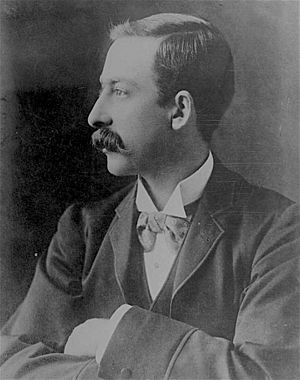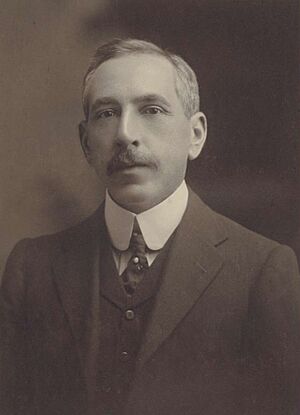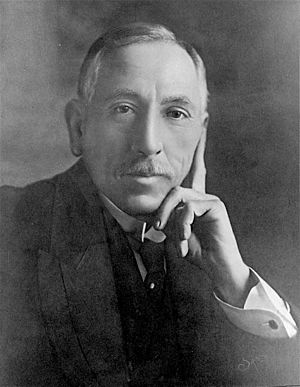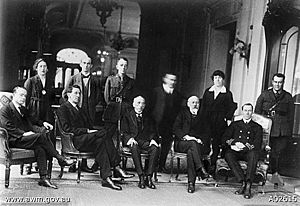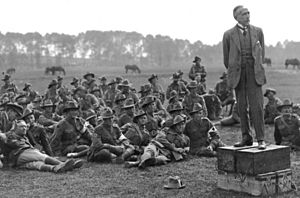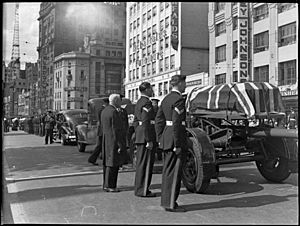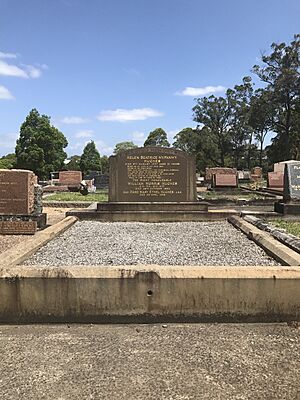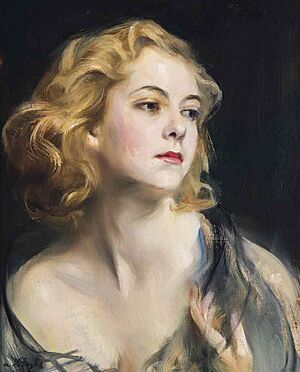Billy Hughes facts for kids
Quick facts for kids
Billy Hughes
|
|||||||||||||||||||||||||||||||||||||||||||||||||||||||||||||||||||||||
|---|---|---|---|---|---|---|---|---|---|---|---|---|---|---|---|---|---|---|---|---|---|---|---|---|---|---|---|---|---|---|---|---|---|---|---|---|---|---|---|---|---|---|---|---|---|---|---|---|---|---|---|---|---|---|---|---|---|---|---|---|---|---|---|---|---|---|---|---|---|---|---|
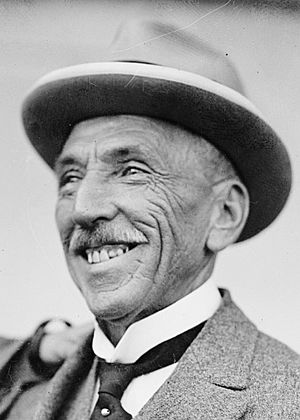
Hughes in 1919
|
|||||||||||||||||||||||||||||||||||||||||||||||||||||||||||||||||||||||
| 7th Prime Minister of Australia | |||||||||||||||||||||||||||||||||||||||||||||||||||||||||||||||||||||||
| In office 27 October 1915 – 9 February 1923 |
|||||||||||||||||||||||||||||||||||||||||||||||||||||||||||||||||||||||
| Monarch | George V | ||||||||||||||||||||||||||||||||||||||||||||||||||||||||||||||||||||||
| Governor-General | Sir Ronald Munro Ferguson Lord Forster |
||||||||||||||||||||||||||||||||||||||||||||||||||||||||||||||||||||||
| Preceded by | Andrew Fisher | ||||||||||||||||||||||||||||||||||||||||||||||||||||||||||||||||||||||
| Succeeded by | Stanley Bruce | ||||||||||||||||||||||||||||||||||||||||||||||||||||||||||||||||||||||
|
|||||||||||||||||||||||||||||||||||||||||||||||||||||||||||||||||||||||
|
|||||||||||||||||||||||||||||||||||||||||||||||||||||||||||||||||||||||
|
|||||||||||||||||||||||||||||||||||||||||||||||||||||||||||||||||||||||
| Personal details | |||||||||||||||||||||||||||||||||||||||||||||||||||||||||||||||||||||||
| Born |
William Morris Hughes
25 September 1862 Pimlico, London, England |
||||||||||||||||||||||||||||||||||||||||||||||||||||||||||||||||||||||
| Died | 28 October 1952 (aged 90) Sydney, New South Wales, Australia |
||||||||||||||||||||||||||||||||||||||||||||||||||||||||||||||||||||||
| Resting place | Macquarie Park Cemetery and Crematorium | ||||||||||||||||||||||||||||||||||||||||||||||||||||||||||||||||||||||
| Political party | Labor (to 1916) National Labor (1916–17) Nationalist (1917–29) Independent (1929) Australian (1929–31) United Australia (1931–44) Independent (1944–45) Liberal (from 1945) |
||||||||||||||||||||||||||||||||||||||||||||||||||||||||||||||||||||||
| Height | 5 ft 6 in (1.68 m) | ||||||||||||||||||||||||||||||||||||||||||||||||||||||||||||||||||||||
| Spouses | Elizabeth Cutts Mary Campbell |
||||||||||||||||||||||||||||||||||||||||||||||||||||||||||||||||||||||
| Children | 7 | ||||||||||||||||||||||||||||||||||||||||||||||||||||||||||||||||||||||
| Occupation | Politician • lawyer | ||||||||||||||||||||||||||||||||||||||||||||||||||||||||||||||||||||||
| Signature |  |
||||||||||||||||||||||||||||||||||||||||||||||||||||||||||||||||||||||
William Morris Hughes (25 September 1862 – 28 October 1952) was Australia's seventh prime minister. He served from 1915 to 1923. He is most famous for leading Australia during World War I.
Hughes had a very long career in politics. He was a member of the federal parliament from when Australia became a nation in 1901 until he died in 1952. This means he served for over 50 years, which is a record! During his time, he was part of six different political parties and led five of them.
Hughes was born in London to Welsh parents. He moved to Australia when he was 22. There, he became involved in the early Australian labour movement, which worked to improve conditions for workers. He was first elected to the New South Wales Legislative Assembly in 1894. Then, in 1901, he joined the new federal parliament. While starting his political career, Hughes also studied law and became a lawyer in 1903.
He first became a government minister in 1904. He later served as the Attorney-General of Australia in Andrew Fisher's governments. In 1914, he was chosen as the deputy leader of the Australian Labor Party.
Contents
Early Life and Education
Childhood in Wales and London
William Morris Hughes was born on 25 September 1862, in Pimlico, London, England. His parents, William and Jane, were both from Wales. His father was a carpenter, and his mother worked as a domestic servant. Billy was their only child.
When he was six, his mother passed away. His father sent him to live with relatives in Wales. He stayed with his aunt, Mary Hughes, in Llandudno during school terms. He helped her with chores and sang in the church choir. During holidays, he visited his mother's family in Llansantffraid-ym-Mechain.
Hughes loved his time in Wales and was very proud of his Welsh background. He later spoke at Saint David's Day celebrations in Australia.
At age eleven, Hughes went to St Stephen's School in Westminster, London. He was a good student and won prizes in geometry and French. After school, he became a "pupil-teacher" for five years. This meant he taught younger students while also getting lessons himself. He met the famous poet Matthew Arnold at school, who encouraged his love for books.
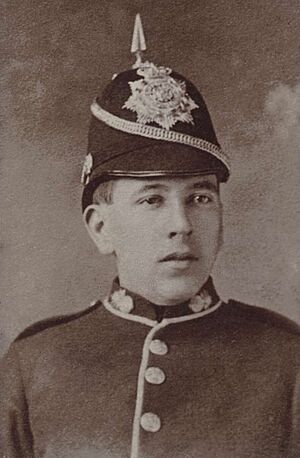
After teaching for a while, Hughes decided he didn't want to be a teacher forever. He joined a volunteer army group called the Royal Fusiliers.
Starting a New Life in Australia
Arrival and Early Jobs
When he was 22, Hughes decided to move to Australia because he felt his chances in London were limited. He arrived in Brisbane, Queensland, on 8 December 1884, after a two-month journey by ship.
For the next two years, he worked many different jobs. He was a fruit picker, a farmhand, and even helped with blacksmithing. He traveled a lot, mostly on foot, across Queensland and into New South Wales.
Moving to New South Wales
Around 1886, Hughes moved to Sydney, New South Wales. He worked as a cook and eventually found a steady job making hinges. He started a family with Elizabeth Cutts, and they had six children together.
In 1890, Hughes moved to Balmain. He opened a small shop selling various goods. To make enough money, he also worked as a locksmith and sold umbrellas.
Beginning His Political Career
Becoming a Politician and Lawyer
In Balmain, Hughes became interested in politics and joined the Australian Socialist League. He was also an organiser for the Australian Workers' Union. In 1894, he was elected to the New South Wales Legislative Assembly as a member of the Labor Party.
While in parliament, he became the secretary of the Wharf Labourer's Union. In 1900, he helped create and became the first national president of the Waterside Workers' Union. During this time, he also studied law and became a lawyer in 1903.
In 1901, when Australia became a federation, Hughes was elected to the first federal Parliament. He became the Labor MP for West Sydney. He believed Australia should have its own strong defense.
He served as Attorney-General of Australia in Andrew Fisher's Labor governments from 1908 to 1909, 1910 to 1913, and 1914 to 1915.
In 1913, at the ceremony to establish Canberra as Australia's capital, Hughes spoke about the country's journey. He was known for his strong opinions and sometimes difficult personality.
Prime Minister of Australia
In October 1915, Andrew Fisher retired as Prime Minister due to health issues, and Hughes took over. World War I was the biggest challenge at the time.
World War I Leadership
Hughes strongly supported Australia's involvement in World War I. After many soldiers were lost in 1916, he believed that Australia needed to introduce conscription. This meant making it compulsory for men to join the army and fight overseas.
However, many members of his own Labor Party, especially those with Irish Catholic backgrounds and trade unionists, strongly disagreed. They were against forcing people to fight overseas.
In October 1916, Hughes held a national vote (plebiscite) on conscription. It was narrowly defeated. This caused a deep split within the Labor Party. In November 1916, Hughes and his supporters were expelled from the party.
Hughes then formed a new party called the National Labor Party. A few months later, this party merged with the Liberals to create the Nationalist Party of Australia. Hughes became the leader of this new party.
At the 1917 Australian federal election, Hughes and the Nationalists won a huge victory. He held another vote on conscription in December 1917, but it was defeated again. Despite this, he remained Prime Minister.
Key Achievements as Prime Minister
Hughes's government created important new organisations. In 1916, he set up the Advisory Council on Science and Industry, which later became the CSIRO. This was Australia's first national body for scientific research.
He also encouraged long-distance aviation. After the war, he offered £10,000 for the first successful flight from Britain to Australia. In December 1919, brothers Ross and Keith Smith won the prize, landing their plane in Darwin. This flight brought Australia global attention and helped lead to the creation of Qantas, one of the world's earliest airlines.
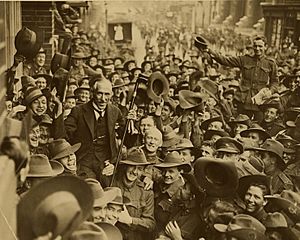
In 1919, Hughes attended the Versailles Peace Conference in Paris. This was the first time Australia had signed an international treaty on its own. At the conference, Hughes argued strongly for Australia's interests. He made sure Australia gained control of the former German New Guinea.
He also strongly opposed Japan's proposal for racial equality to be included in the treaty. This was because he wanted to protect Australia's White Australia policy, which limited immigration from non-European countries.
End of Prime Ministership
After 1920, Hughes's political power began to weaken. Some members of his own party didn't fully trust him. A new party, the Country Party, was formed. They were unhappy with some of Hughes's policies, especially those affecting farmers.
At the 1922 Australian federal election, the Nationalists lost their majority in parliament. They needed the Country Party's support to form a government. However, the Country Party leader, Earle Page, refused to work with Hughes as Prime Minister.
Under pressure, Hughes resigned in February 1923. He was replaced by his Treasurer, Stanley Bruce. Hughes had been Prime Minister for eight years, a long time for that era.
Later Political Life

After losing the prime ministership, Hughes remained in parliament. He was unhappy about being removed from power. In 1929, he led a group of politicians who voted against the Bruce government, causing it to fall. Hughes was then expelled from the Nationalist Party.
He formed his own party, the Australian Party. In 1931, he joined forces with other non-Labor politicians to form the United Australia Party (UAP).
In the 1930s, Hughes returned to government as a minister. He became known for warning about the growing threat of Japan and the coming of another war. He believed Australia needed to strengthen its own defenses.
World War II and Final Years
Defence became a major issue with the rise of Fascism in Europe and Japan in Asia. Hughes continued to serve in government under Prime Minister Joseph Lyons and later Robert Menzies.
When World War II began in September 1939, Hughes was part of the special War Cabinet. In 1941, Menzies resigned as Prime Minister. The UAP chose Arthur Fadden to lead the government, with Hughes remaining a minister. However, this government soon fell, and John Curtin became Prime Minister.
Hughes, at 79, was briefly chosen as the leader of the UAP in opposition. He criticised the British government's weakness in the Far East and praised the United States' armed forces after the Battle of the Solomons.
In 1943, the UAP suffered a big defeat in the federal election. Hughes then handed the leadership back to Menzies. In 1944, Hughes was expelled from the UAP again. He sat as an independent politician until 1945, when he joined the new Liberal Party of Australia.
Hughes continued to serve in parliament. He was re-elected for the 20th and final time in 1951. His last speech in parliament was about selling off a government-owned oil company, which he had helped create.
Death and Legacy
William Morris Hughes died on 28 October 1952, at the age of 90, at his home in Lindfield. His state funeral in Sydney was one of the largest Australia has ever seen, with about 450,000 people lining the streets. He was buried at Macquarie Park Cemetery and Crematorium.
Hughes is the oldest person ever to have been a member of the Australian parliament. He served in the House of Representatives for over 51 years. Including his time in the New South Wales parliament, he was an MP for a total of 58 years, never losing an election. This is still a record in Australia.
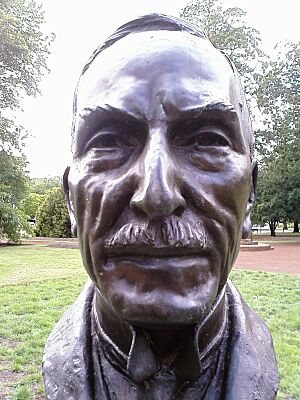
Hughes was a small, thin man with a distinctive voice. During World War I, soldiers affectionately called him the "Little Digger." He is remembered for his strong political skills, his clever sayings, and his positive spirit and love for Australia. However, many in the Australian labour movement never forgave him for leaving the Labor Party.
Personal Life
Family Life
Soon after arriving in Sydney, Hughes started a family with Elizabeth Cutts. They had six children together. Their family life was sometimes challenging due to Hughes's dedication to his work and frequent travel. Elizabeth passed away in 1906.
In 1911, Hughes married Mary Ethel Campbell. Mary was very good with people and politics, and Hughes often asked her for advice. She always travelled with him on his trips, even during wartime.
Hughes had one child with Mary, a daughter named Helen, born in 1915. He loved her very much and was deeply saddened when she passed away at a young age in 1937.
Health and Personality
Hughes had significant hearing loss that got worse as he got older. He used an early type of hearing aid. He was also known for his strong will and sometimes difficult personality. He was short and thin, but very dedicated to staying fit.
Honours and Recognition
- He was made a King's Counsel (KC) in 1909.
- He became a member of the Queen's Privy Council for Canada (PC) in 1916.
- He received the Order of the Companions of Honour (CH) in 1941.
- He was awarded the Grand Officer of the Legion of Honour in 1941.
Hughes was offered a peerage (a title like a lord) and knighthoods, but he turned them down. He famously said, Good God, David! Do you want to ruin me? I am Labor Prime Minister of Australia and President of the Waterside Workers' Federation.
He received "Freedom of the City" awards from many cities in the United Kingdom, including London, Edinburgh, and Glasgow. He also received honorary degrees from several universities.
The Division of Hughes (an area for electing a politician) and the suburb of Hughes, Australian Capital Territory in Canberra are named after him. A park in Lane Cove is named 'Hughes Park' after Billy and Dame Mary Hughes.
In 1972, Australia Post issued a postage stamp with his portrait.
The Billy Hughes Bridge near Albury, New South Wales is named after him. It replaced a level crossing where he had a car crash with his wife Mary in 1911.
See also
 In Spanish: Billy Hughes para niños
In Spanish: Billy Hughes para niños
- First Hughes Ministry
- Second Hughes Ministry
- Third Hughes Ministry
- Fourth Hughes Ministry
- Fifth Hughes Ministry
- Racial Equality Proposal
- Billy Hughes egg-throwing incident



